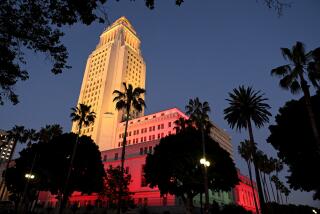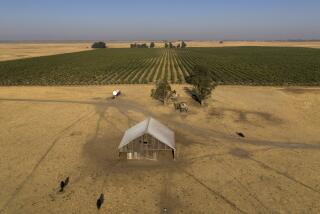Ramona Serious About Cityhood
- Share via
After decades of romancing the idea, Ramonans are scraping together a grubstake to investigate whether this dethroned “Turkey Capital of the World” has what it takes to become a city.
There are those who scoff at the city idea--including a former Turkey Day grande dame--but many who believe it’s time for their backcountry town to bust out on its own.
When he thinks of cityhood, local historian Charles LeMenager pictures a Ramona free from the meddling of faraway county government--a Ramona in command of its own destiny.
“The county is gridlocked practically,” said LeMenager, author of the book, “Ramona & Roundabout.” “Every little piddley thing that comes up, they want to make a big thing out of. I think lack of control of land-use matters is really the crux of the whole thing. It takes you an ungodly period of time to get permits of any kind.”
Others see cityhood as an overdue challenge to the town’s major governing body, the volatile, often unpopular Ramona Municipal Water District Board of Directors.
“Cityhood might at least improve the running of the water district,” said Steve White, a citrus and avocado grower who farms about 140 acres in Ramona. “The board’s like a lightning rod for all the problems in Ramona. I’m convinced a lot of people show up there just to let off steam.”
As residents opine, a tiny band of prominent Ramonans is working to settle the question.
Led by Rotary Club President Roy Winchell, the committee has gathered $2,000 in pledges to pay for a professional study of Ramona’s cityhood potential.
Despite their months of donation-seeking, the nameless group insists it isn’t trying to push Ramona toward cityhood. It just wants to know whether it’s possible.
“Our goal is not to support cityhood,” Winchell said, “but to get an accurate evaluation of whether or not we’re feasible. We want to take it slow and easy and make sure it’s the right thing to do.”
Armed with a one-page flyer “in big print” to prevent misunderstandings about their mission, says Winchell, the group hopes eventually to raise the remaining $6,000 price of the study.
It’s not the first attempt for Winchell’s group.
In 1990, some of the same people conducted their own cityhood study, wanting to spare the expense of hiring a professional. After months of amateur statistic-gathering and number-crunching, they concluded that Ramona wasn’t ready to leave the county nest.
But their own findings didn’t convince them.
“The problem was, we didn’t really know what we were doing,” said Winchell, a building contractor.
The cityhood group has already picked John McTighe, an El Cajon financial consultant, to do its study.
Over the past decade, McTighe says he’s studied half a dozen towns and never found one that he didn’t think could stay afloat as cities. Two of those, Encinitas and Temecula, later incorporated.
But whether Ramona can fly as a city, McTighe couldn’t say for sure.
“I’m encouraged by seeing the number of (businesses) that have grown up there over the past few years,” he said. “That’s the key to incorporation nowadays, the sales tax.”
Joe Convery, a staff analyst for the Local Agency Formation Commission, said a city’s sales tax should generate 30% to 40% of its income. And when Ramona’s 1990 statistics were checked, “it didn’t look favorable.”
As the dreams and schemes continue, the population keeps growing.
Even though the town is far from a freeway, in the foothills of the Cuyamaca Mountains, the city slickers and housing developers have found Ramona.
The yuppies have come, trading the rat race for a rustic valley where people still dig their own wells and wayward livestock still amble down Main Street.
Masses of retirees have also settled in Ramona, following the advice of four magazine articles that rated the town one of the nation’s best spots to spend your golden years.
Since 1978, the town’s population has tripled. It now stands at about 35,000.
If McTighe decides it’s time to become a city, Ramona will have taken its first baby step through the procedural ballet that leads to incorporation.
The next steps are: circulating a petition and getting approval of 25% of residents inside the proposed city; submitting a cityhood study, the petition and a $10,000 fee to the Local Agency Formation Commission; getting an analysis and recommendation from the LAFCO staff; holding a public hearing and getting the OK from the LAFCO board; getting the county Board of Supervisors to call for an election, and finally, winning approval of the majority of voters inside the proposed city’s boundaries.
Over on Main Street in the Chamber of Commerce office, 74-year-old secretary Mary Kay Pinkard doesn’t need another study to tell her what she thinks about Ramona’s suitability for cityhood.
“That would ruin us,” said Pinkard, who was born in 1918 on the same street where she works. “The town would go bankrupt the first year.”
This opinion comes from a woman who’s lived in Ramona so long she is displayed in the town museum. A 1947 photo shows her wearing a strapless turkey-feather gown and matching parasol, a symbol of the by-gone days when Ramona was known as “A Paradise for Poultry,” and “Turkey Capital of the World”--but never as a city.
Pinkard says a cityhood craze erupts about once every five years, and then fizzles when people realize Ramona doesn’t generate the taxes to keep a city solvent. (A serious attempt in 1982 was shot down early on by LAFCO.)
On Pinkard’s wavelength is Sam Mitchell, a town political animal who likes to fire off angry letters to the local newspaper.
Mitchell insists Ramona doesn’t have the tax base to pay for street maintenance, police, fire protection and all the other services cities provide.
Some residents, Mitchell included, have pointed out that several members of the cityhood-study group are landowners and developers who might like to make it easier to get building permits and to squeeze more houses onto smaller parcels of land.
Winchell, a contractor, agreed that he does own parcels of Ramona land, but said he develops mainly in Arizona, not locally.
Pro-cityhood forces use the same argument to promote their position. Because 17% of the county’s remaining developable land lies in the Ramona area, they say there’s cause to worry that county officials will eventually allow large-scale development and ruin Ramona’s rural feel.
For many residents, one of the most tantalizing mysteries of incorporation is whether a city would win independence from the powerful Ramona Municipal Water District board.
The historically political board consists of five elected officials who control the town’s water, sewer and fire services, and have been known to curse loudly during meetings and throw books and chairs at each other.
Some say it’s time for the board’s iron grip to be loosened.
“They have us under their thumb,” Pinkard said.
Ironically, when the water district was formed in 1925 and held its meetings at a drugstore soda fountain, residents saw it as the precursor to city government, not as a rival.
When the district was approved, 80-4, a happy resident wrote to the Ramona Sentinel:
“A water district for Ramona! And so at last comes not only a victory for progression, but also a grand fruition for the faithful few who by their unstinted efforts and unselfishness have made possible this great forward step in municipal development. I say ‘municipal,’ for that will be the next logical step in Ramona’s development.”










